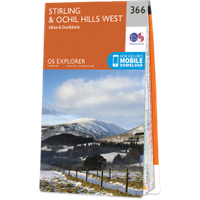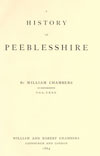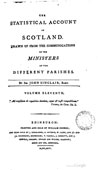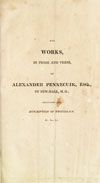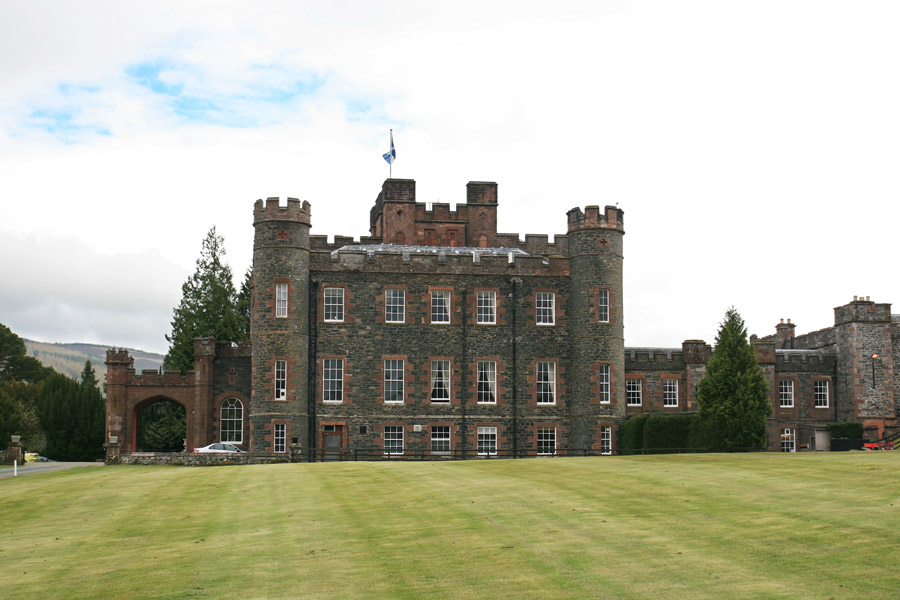

Stobo Castle is a 19th century castellated mansion built on the site of the old castle of Hillhouse.
Exactly when the first castle was built at Stobo is unknown, however given that Stobo appears to have been a very early barony, and the turbulent nature of life in the Borders it is likely that there was a defensive building on the site quite early on.
The nearby Stobo Kirk is one of the oldest churches in Scotland still standing, and dates largely from 1120 although there are also elements of 11th century Norman architecture.
The earliest mention of Stobo seems to come in the late 12th century, when a David de Stobhou witnessed charters. Around 1200 a charter defines the correct boundaries between Stobo, Happrew and Kirkurd. An Adam de Stobhou was a juror at an inquest in Peebles in 1262. Stobo seems to have been a Church property at least as far back as the mid-13th century.
Within the barony of Stobo was a tower called Hillhouse, which was one of a series of castles spaced out along the Tweed to defend the border. Hillhouse was situated between Easter Dawyck and Dawyck, and while the exact date of its construction isn’t known, the ages of its neighbours suggest it was at least as early as the 16th century, if not much earlier.
It was one of a series of towers along the Tweed valley, each of which was visible from the next. Elibank would signal to Holylee, Holylee to Scrogbank, Scrogbank to Caberston, Caberston to Bold, Bold to Purvishill and then on to a continuing chain from Innerleithen to the north-west.
The signal would then pass along to Traquair, Grieston, Ormiston, Cardrona, Nether Horsburgh, Horsbrugh, Haystoun, Peebles and on to Neidpath. From Neidpath it would continue to Caverhill, Barns, Lyne, Easter Happrew, Easter Dawyck, Hillhouse, West Dawyck, Dreva and on to Tinnis.
Following the Reformation, Stobo seems to have come into the possession of James Douglas, 4th Earl of Morton, in 1577. However Douglas only owned Stobo for four years, his estates forfeited to the Crown in 1581 due to his involvement in the murder of Darnley.
James VI gave Stobo to the Archbishop of Glasgow, but then subsequently gave it to his Lord Chancellor, Sir John Maitland, 1st Lord Maitland of Thirlestane, in 1592. Maitland died in 1595, and in 1603 James VI gave Stobo to Ludovic Stewart, 2nd Duke of Lennox, and in 1608 to the Archbishop of Glasgow once again.
In 1613 the Archbishop granted a charter of the lands and barony of Stobo, including the superiority of the lands of Dreva, to James Tweedie of Dreva.
In 1619 the Tweedies sold the barony of Stobo to John Murray of Halmyre, and the estate was later incorporated into the lands of Murray of Stanhope. The Murrays are said to have lived in the principal property of the estate, named Hillhouse. However on Joan Blaeu’s map of 1654, based on a late 16th or early 17th century manuscript by Timothy Pont, the property seems to be named Wester Stobo.

Blaeu Atlas of Scotland, 1654
In 1698 Stobo was erected into a free barony once more by a charter to Sir David Murray of Stanhope.
The names Stobo and Hillhouse seem to be interchangeable, as during the 18th century the property appears on maps variously as Hillhouse, Stobo and Stobo House.

William Edgar & Richard Cooper, 1741
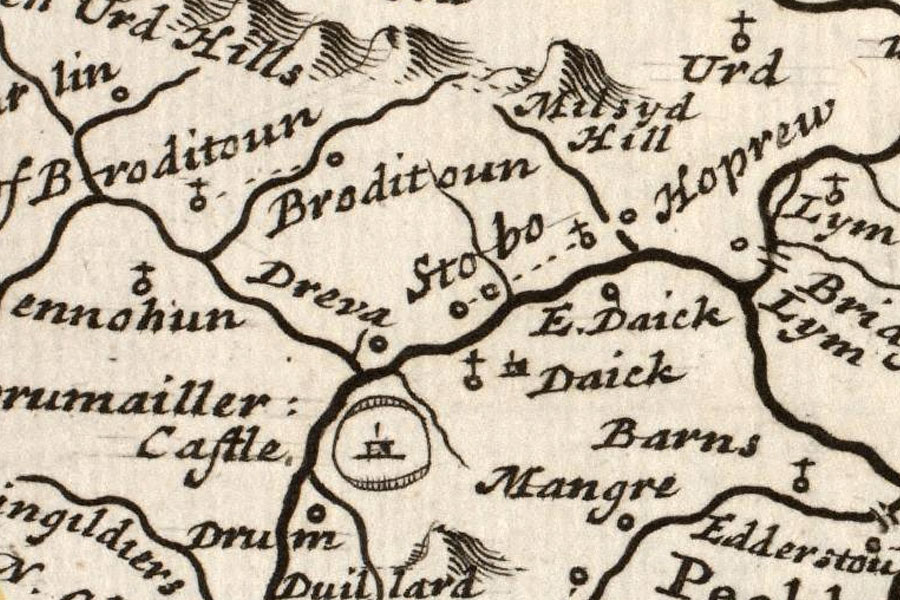
Herman Moll, 1745
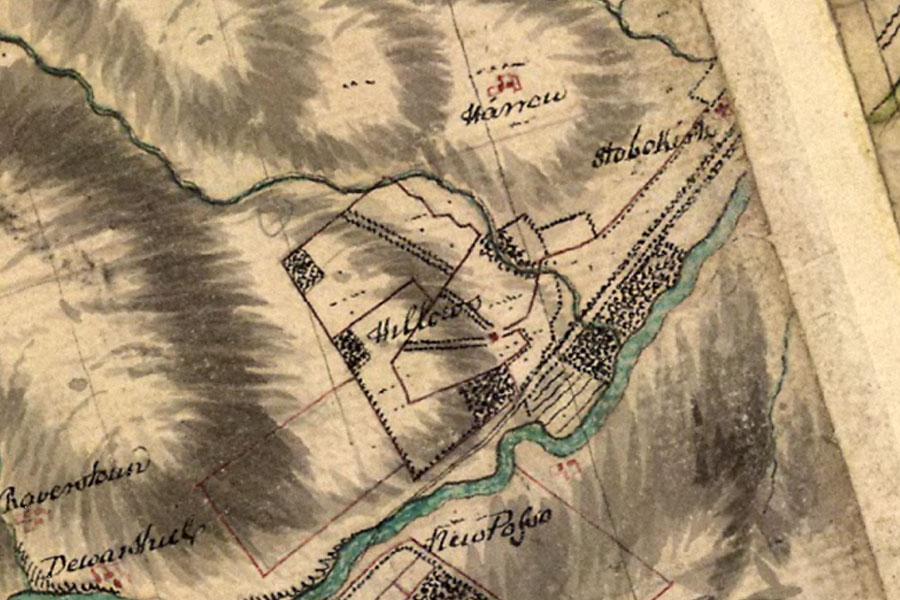
William Roy, 1752 – 1755

Mostyn Armstrong, 1775
During the first half of the 18th century Sir Alexander Murray of Stanhope was responsible for landscaping the grounds of Hillhouse, laying out tree-lined avenues and ornamental gardens. He was succeeded by his son, another Sir David Murray, who fought with Bonnie Prince Charlie at Culloden, which led to his exile in France.
His heir, Charles Murray, prematurely considered the estates his during Sir David’s absence, and published a map with a rather lengthy title:
A Map of the Barony of Stobbo, in the Sheriffdom of Peebles, now belonging to Charles Murray, Esq., with the Parks and improvements made upon it by Sir Alex. Murray, of Stanhope; surveyed by And. Bearhop.
Charles Murray, Esq.
However the estates were then confiscated from Murray, and put up for sale in 1767. They were bought by Sir James Montgomery, 1st Baronet, of Stanhope, Lord Chief Baron of the Court of Exchequer, for the sum of £40,500.
Montgomery set about improving the estate, and was responsible for planting on Quarry Hill, establishing parkland, creating the south drive, and possibly building the walled garden. Montgomery died in 1803 and was succeeded by his second son, also Sir James, who continued his father’s work in developing the estates.
This Sir James demolished the old Hillhouse, and between 1805 and 1811 he built a new and grand house on the site of it, designed by the architects Archibald and James Elliot, and inspired by Inveraray Castle. He named it Stobo Castle, and would later be known as Sir James Montgomery, 2nd Baronet, of Stobo Castle, Stanhope.

William Chambers, Edinburgh, 1864
The 2nd Baronet married, secondly, Helen, daughter of Thomas Graham of Kinross House, and their children took the name Graham-Montgomery. Succeeded by his eldest son from his second marriage, Sir Graham Graham-Montgomery, 3rd Baronet, in 1839, who received all of his father’s property.
Following his death in 1901 Stobo passed to his eldest son, Sir James Gordon Henry Graham-Montgomery, 4th Baronet, formerly a Lieutenant-Colonel in the Coldstream Guards, but he was tragically killed in an accident on an overnight train to London.
Two sets of death duties in quick succession put a severe strain on the family’s finances, and Stobo was sold by the 3rd Baronet’s second son, Sir Basil Templer Graham-Montgomery, 5th Baronet, to Hylton Philipson, a cricketer, for £90,000. In 1896 Philipson had married Nina, fourth daughter of Montolieu Oliphant-Murray, 1st Viscount Elibank, and their children took the name Murray-Philipson.
Philipson was responsible for modernising the interior of the castle, extending and developing the terraced gardens to the south of the castle, creating a small loch and a Japanese-style water garden, the installation of a hydroelectric scheme on the Weston Burn, and building a bowling green, tennis court and recreation hall.
Stobo Castle was inherited by Philipson’s son Hylton Ralph Murray-Philipson, however he died in 1934 at the age of 31. In 1939 Stobo Castle was bought by Wenefryde Agatha Scott, 10th Countess of Dysart, however the onset of World War II meant that the castle was rarely inhabited at this time. Between 1941 and 1971 parts of the wider estate were sold off, and the castle and garden went into a slow decline.
The Countess lived at Stobo until the mid-1960s, after which it lay empty for over 10 years. In 1971 Leo Seymour bought the majority of the former estate, while Stobo Castle and its immediate grounds were acquired by the Winyard family in 1975, who spent the next few years transforming the castle into a luxury health spa, which opened in 1978.
Today Stobo Castle continues to be run as a luxury health spa and hotel.
Alternative names for Stobo Castle
Hill House; Hillhouse; Hillhouse Tower; Stobbo; Stobbou; Stobhou; Stobo House
Where is Stobo Castle?
Stobo Castle is in the parish of Stobo and the county of Peeblesshire.
Grid reference: NT 17298 36660
Lat / long: 55.616474, -3.3146267


